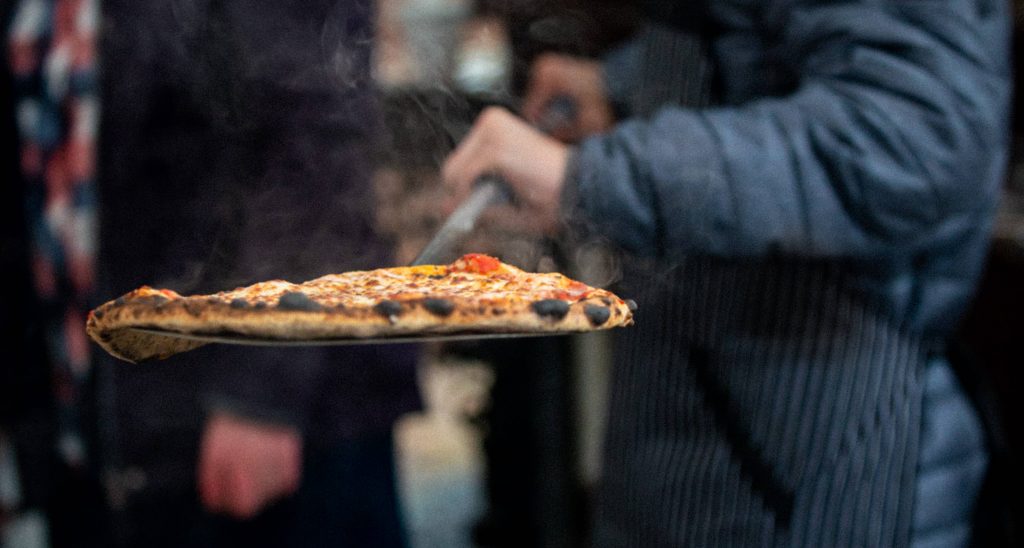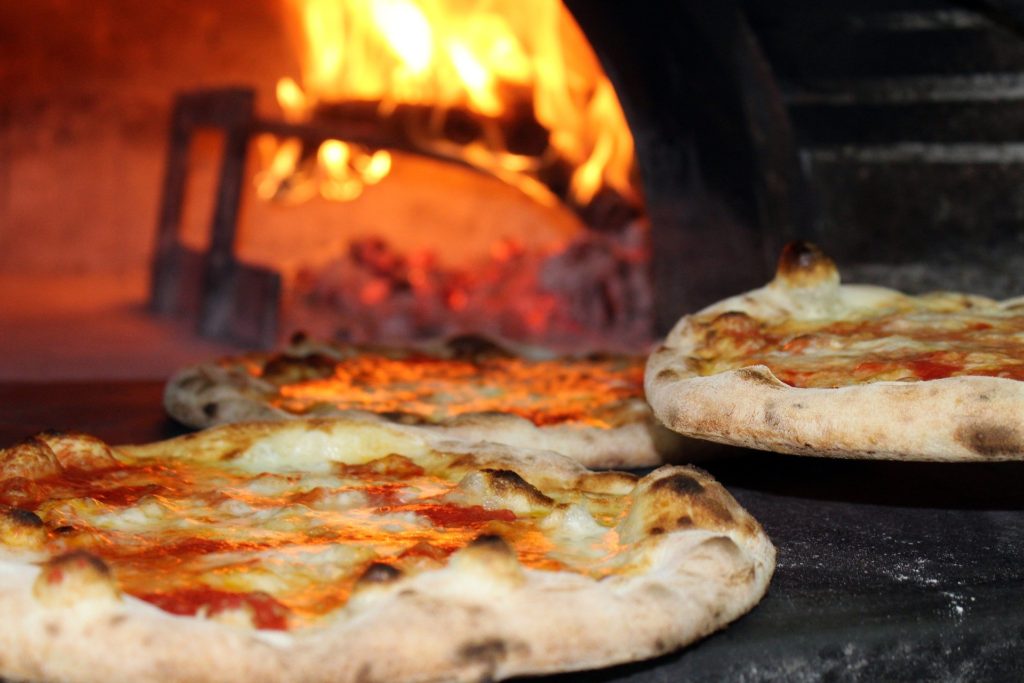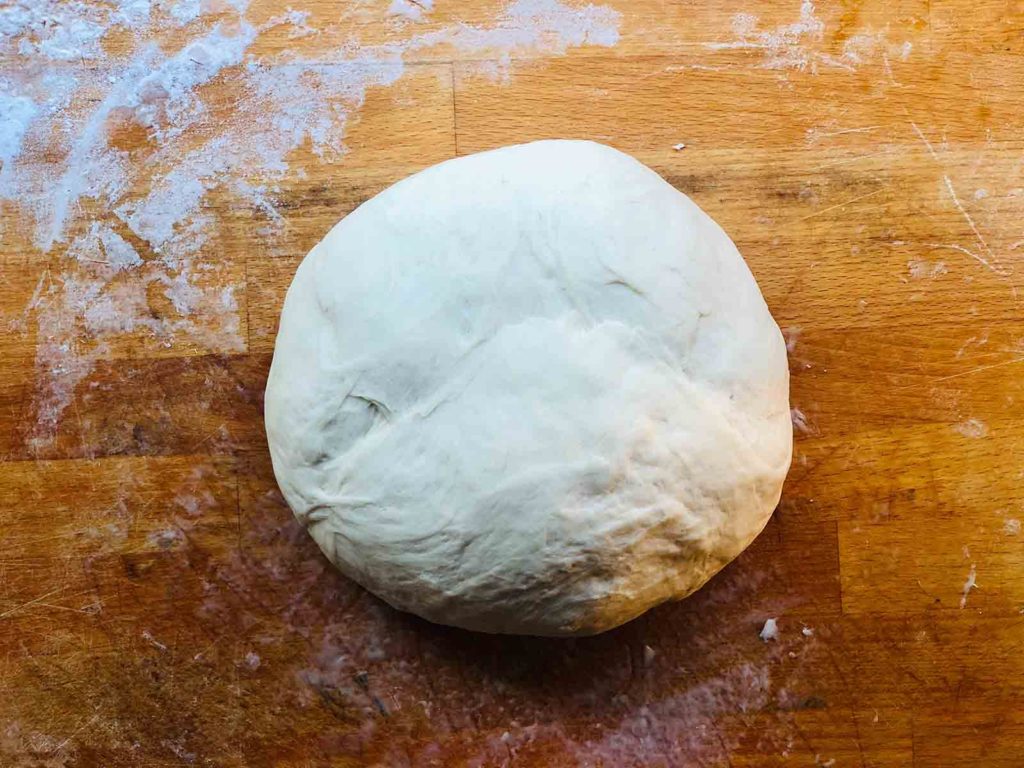Burnt pizza sucks! It can even be dangerous to eat. Luckily there are a few simple things you can do to prevent your pizza from burning.
Should PIzza Be Burnt? (Burnt vs Charred)
If you’ve ever had pizza in a classic pizzeria, the pizza probably came straight from the wood-fired oven. And you might have noticed the small, burnt spots on the crust. Should it really be like that? Or do they constantly burn your pizza?
Neapolitan pizza is traditionally served with a charred crust. Often small charred spots are referred to as leoparding. Part of the reason for this leopard-pattern is the fast bake in the hot wood-fired oven. But the charred spots also add flavor to the crust. You’ll find charring both on the top and bottom of the pizza. But it’s important to emphasize that there is a difference between burnt and charred pizza.
When you bake pizza at a high temperature, the sugars in the flour will caramelize and create a savory and slightly bitter flavor. This is what you’re typically looking for in a Neapolitan pizza because the savory bitterness combined with tomato sauce and creamy mozzarella creates a great balanced flavor combination. The trick is to pull out the pizza right before the combustion process starts, or else you’ll end up with burnt pizza – which you don’t want!

If you leave the pizza in the oven for too long, the combustion of the crust will start and you’ll get a black extremely bitter, and bad-tasting crust. If left long enough the pizza might even turn into coal.
Is It Safe to Eat Burnt Pizza?
There is a debate about the health implications of burnt foods. Research shows that bread baked at high temperatures form the chemical acrylamide. This chemical has been shown to cause cancer in animals and is therefore also a human health concern, according to the FDA (source). You should therefore be careful consuming burnt pizza, as this might be bad for your health.
Why Pizza Crust Burns
There are many reasons your pizza burns. The most obvious is temperature and time, but also the ingredients in your dough, excess flour and use of cold pizza dough can result in a burnt crust. The method you use to bake your pizza also determines how fast it will burn, depending on the heat source. Sometimes it’s the top that burns first, while other times its the bottom.
Let’s take a look at all these individual factors, and how we can prevent burning.
Time and Temperature
The most important factors in burning anything are temperature and time. Whether you bake pizza in a wood-fired
Balance Between the Baking Top and the Bottom
You need a balance between the baking temperature of the top and bottom of the pizza. If the baking surface is too hot, the bottom of the pizza burns before the top is done. Likewise, if the heat from above the pizza is too hot compared to the baking surface, the toppings may burn while the bottom is still raw.
You have to keep an eye on the pizza when it’s baking. It’s also important to check the bottom of your pizza for doneness since it’s hard to visually tell when it’s done. This can be done using a
Different baking methods have different challenges when it comes to finding this balance. Some have a higher risk of burning the top, while others have a high risk of burning the bottom of the pizza. It’s therefore important to understand your baking method.
How To Avoid Burnt Pizza in a Wood-FiredPizza Oven
It’s challenging to control the temperature in a wood-fired
In a wood-fired oven, you need a balance between the temperature of the floor (the baking surface) and the radiating heat from the dome. To make sure the floor is nice and hot, it’s common to start the fire in the middle of the oven and move to the back or the side before baking pizzas. The dome shape of the oven will allow the heat to circulate and radiate from the dome to bake the top of the pizza.
One thing you should be aware of is that the floor rarely has an even temperature. It will be hotter closer to the fire. And in addition to that, it can have hotter and cooler spots.
A useful tool to check this is an infrared thermometer. By using that, you know when your oven has reached the right temperature. You can also check the temperature of the floor and the dome of the oven. And you’ll know where the cold and hot spots on the floor are.
Since the oven is hotter closer to the flames. You might have to turn the pizza to get an even bake and avoid that one side of the pizza burns. In a wood-fired oven, the easiest way to do this is by using a turning peel, that’s specifically designed for this. Alternatively, you can use your regular
I also recommend checking how the bottom of the pizza is doing during baking. You can do this with a

How To Avoid Burnt Pizza in a Home Oven
The causes of burnt pizza in a home oven depend on how you bake your pizza. If you bake it on a baking sheet at 450°F, the only concern is time. If you bake pizza on a pizza stone or
Baking on a Baking Sheet
Baking pizza on a baking sheet provides pretty even heat from both above and underneath. The main risk is therefore time. So keep an eye on the pizza, and pull it out before it burns.
Baking With a Pizza Stone or Steel
This is one of my personal favorite ways of baking pizza at home. The reason is that you can make amazing Neapolitan-style pizza this way. The challenge is that a pizza stone or steel will bake the bottom of the pizza faster. You, therefore, need a heat source that will speed up the baking of the top of the pizza.
The best way to do this is by using the broiler or grill function. By doing that, you can even make the characteristic charred, leopard-pattern on the curst! But be careful, your pizza crust will go from done to burnt very quickly using the broiler.
You need a balance between the heat of the stone or steel and the broiler. In short, a thicker stone, or steel, will retain more heat when you pre-heat it, which will bake the pizza faster. So if your oven gets really hot, you should consider a thicker stone or steel to bake the pizza at an even rate. But if your oven can’t get that hot, or you don’t have a broiler, a thinner stone or steel is a better choice. I will not go into details, but you can check the best thickness for different oven temperatures and how it relates to baking time here.
Like in a
If you want to know more about proper baking in a home oven check out my step-by-step guides to baking on a pizza stone or a pizza steels.
Pizza in a Portable Pizza Oven
Baking pizza in a small, portable oven, such as an Ooni
Pizza on the Grill
The main challenge of baking pizza on a grill is that the heat source is underneath the pizza. This increases the risk of burning the bottom before the top is done.
The easiest way to prevent burnt pizza on the grill is to bake one side of the pizza first. Then pull it off the grill, turn it (so the baked side is facing up), and top the pizza. The hot crust will help the cheese melt and the toppings start cooking. Then place it back on the grill with the lid on. Try to avoid opening the lid as little as possible, since you need all that heat to properly bake your toppings.
I also recommend using indirect heat, since heat right under the pizza will burn it much quicker.
The Type of Dough
Certain ingredients will burn faster than others, so if you bake pizza at a high temperature, you want to decrease or completely cut these ingredients. Neapolitan pizza is designed for baking at really hot temperatures and is therefore a great starting point if you struggle with burnt pizza. Check out the authentic Neapolitan pizza recipe.

Your Dough Contains Too Much Oil
A lot of pizza dough recipes, both online and in cookbooks, ask for olive oil in the dough. Oil, and other fats, lead to heat well, which will speed up the baking process. This can be beneficial when you bake thick-crust pizza at a lower temperature. But it will also make your pizza burn faster.
This is the reason Neapolitan pizza uses lean dough. A dough without any fat. When you bake pizza in a blazing hot wood-fired oven, you actually want the dough to bake and brown as little as possible to prevent burning.
The same principles apply if you bake pizza in a hot home oven on a pizza stone or steel. You should consider leaving the oil out, or at least reduce the amount in the dough.
Your Dough Contains Too Much Sugar
Another ingredient you often find in pizza dough is sugar. Sugar is typically the first thing that will brown and burn in your pizza dough. The reason is that sugar starts to caramelize at 320°F (160°C). Sugars can therefore help your crust brown faster, but it will also burn faster.
Just like oil, sugars are not found in traditional Neapolitan pizza dough, because it doesn’t play well with the high heat. So if your pizza crust burns, consider reducing or cutting sugar completely from your dough.
You Use the Wrong Type of Flour
Flour also contains carbohydrates, including small amounts of sugar. So how fast flour burns depends on the type of flour you use.
If you want to bake pizza in a
Caputo is a local mill in Naples, Italy that provides flour to the local pizzerias. I have tried a bunch of their flours and had great success. If you want to read more, check out my article: Caputo 00 Flour: Everything You Need to Know.
The Dough is Too Cold
If you bake cold pizza dough, stretch in the dough will burn. This is often referred to as measles, in pizza baking. The reason is that it is a chemical process when the cold starch is exposed to high heat causing it to burn quicker. So if you e.g. cold-ferment your dough, leave it at room temperature for at least 2-3 hours before baking the pizza.
Too Much Flour on the Dough
Excess flour on the dough or peel is likely to burn in the oven. Fine wheat flour that’s exposed to high heat burns and creates bad odors and flavor to your pizza. You, therefore, want to avoid excess flour when you bake your pizza.
First, try to shake off excess flour from the dough. Another thing you can do is to use a perforated pizza peel. This is a peel with a carrying surface filled with small holes that are designed to get rid of flour from your dough. The added airflow also prevents sticking, compared to a whole metal-carrying surface. And it allows you to use less flour when dusting the peel.
This lightweight premium, anodized aluminum peel features a balanced 12x14-inch blade for effortless handling and a perforated surface to reduce sticking.
Fine wheat flour is not ideal for dusting your
How to Prevent Burnt Pizza in 4 Easy Steps
To Prevent burning just follow these 4 steps:
1. Know Your Baking Method and Control Time and Temperature
Different baking methods require different care. But the most important thing is to have the right balance between baking the top and bottom of the pizza.
Wood or gas-fired pizza ovens tend to get very hot you should therefore use an infrared thermometer to check the temperature. A turning peel is also an important tool to reach the pizza to check that the bottom doesn’t burn. If the bottom is baking faster than the top, lift the pizza towards the hot dome using your peel to finish it faster.
The most common case for burnt pizza baked on a baking sheet t in a home oven is simply that you left it for too long. If you use a pizza stone or steel, on the other hand, you need the balance between baking the top and bottom, just like in a
On the grill, the main challenge is that the heat source is underneath the pizza. This results in a much faster bake of the bottom. The best way to deal with this is to use indirect heat and close the lid to trap as much heat as possible that can bake the top. Baking one side of the pizza, burning and topping it, and then baking the bottom will help the top bake faster.
2. Use the Right Type of Dough
Reduce, or cut completely, oil and sugar in your dough. Oil will lead to heat, baking the pizza faster, and sugar will caramelize and burn at a fairly low temperature.
The flour can also burn in the oven, so you should go for a color that can handle it, such as Caputo Pizzeria (affiliate link).
3. Don’t Use Cold Pizza Dough
The starch will burn more easily if the dough is cold, and create a measles-like pattern. Therefore, leave your pizza dough at room temperature for at least 2-3 hours before you start preparing your pizza.
4. Avoid Excess Flour
Wheat flour in powder form burns quickly. You should therefore get rid of excess flour from your dough. Using a perforated
- Is Your Pizza Dough Too Dry? Here is How to fix it! - June 10, 2024
- The Ultimate Guide to the Pizza Dough Windowpane Test - June 8, 2024
- The Ultimate Guide to Autolyse Pizza Dough - June 7, 2024


I use oo flour at the lowest temperature in my ooni 16 , the pizza burns ever time, before the bottom get’s crunchy. What am I doing wrong ?
Hi, what kind of pizza are you trying to make? Personally, I mostly make Neapolitan pizza in my Ooni oven, and Neapolitan pizza shouldn’t be that crispy. I guess you’re making some sort of New York-style pizza. In that case, I would both pre-heat and bake the pizza at low, preferably as far away from the burner as possible. When you turn the pizza, you should also make sure to place the pizza back at the same spot, since the pizza cools down the floor of the oven.
It could also be the flour, not every Tipo 00 flour is the same. I almost exclusively use Caputo Pizzeria for my Ooni Oven.
Great article a I am better educated to experiment with my new wood fired oven. The dome temperature was at 900+ degrees and the cheese and the sauce were burning while the dough was still white. I need to get the dome to cool down a bit before I start cooking. Also good to know the Neapolitan pizza is not usually as crispy. I am also thinking of experimenting on a two step process of par-baking the crust and then add the topping similar to the process you described for the grill. Any thoughts?
What kind of oven are you using? And did you check the floor temperature? It’s a bit hard to know what the problem is without more information about your dough, oven, and baking process. Maybe the floor needs more time to get to temperature, or it’s not conductive enough? Too much flour on the dough can also prevent browning.
I am using an Ooni 12” gas oven. I use Caputo 00 pizzeria flour. (blue bag). Oven is on high temperature. Our pies are always burnt on top. The top gets well done and the crust is always too soft. (Not crispy)
Started preheating the Ooni to high and shutting it off completely. The crust gets crispy this way. Then I turn it back on to get the top cooked at the very end. Get best results like this but it bothers me that I can’t make pies with the gas on and the temperature on high. Suggestions welcomed.
Thank you
What kind of pizza are you making?
I think lowering the heat is the answer. But I’m surprised you have to shut it off completely to get an even bake.
Perhaps the problem is that the bottom is not baking fast enough rather than the top is baking too fast? Make sure you preheat the oven long enough before starting to bake pizza. And if you make several pizzas (and especially if you turn the flame off during baking), you might have to re-heat the oven between pizzas.
If the toppings burn, but not the crust and rim, you can introduce, or increase, some oil in your dough. That will speed up the baking and make it crispier.
I’m mostly using an Ooni 16″ oven, and I usually preheat the oven at the highest setting, then turn it down a little bit when baking to prevent the top to burn. I also place the pizza a little further from the flame if it bakes too fast.
And that works well when baking Neapolitan-style pizza, it bakes well in around 90 seconds. It’s not super crispy, but Neapolitan pizza shouldn’t be that crispy.
When I make New York-style pizza I lower the temperature even more, to let the pizza bake for 3-4 minutes to give it time to crisp.